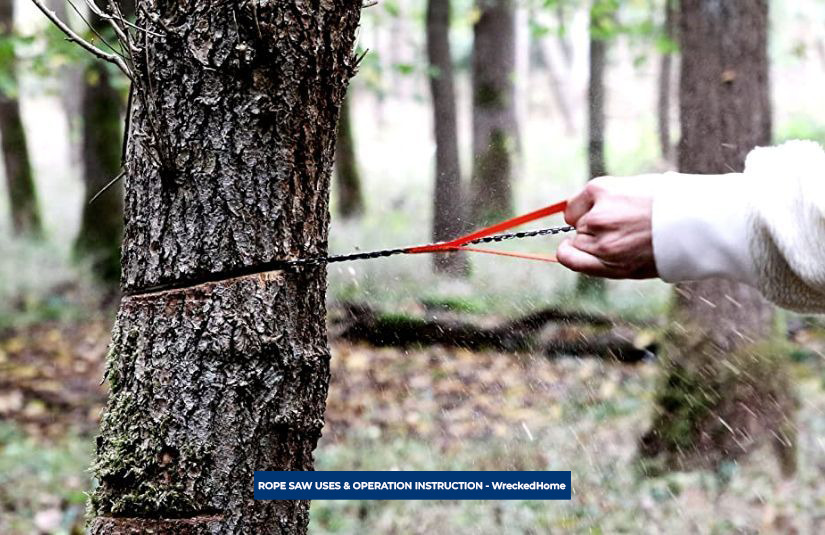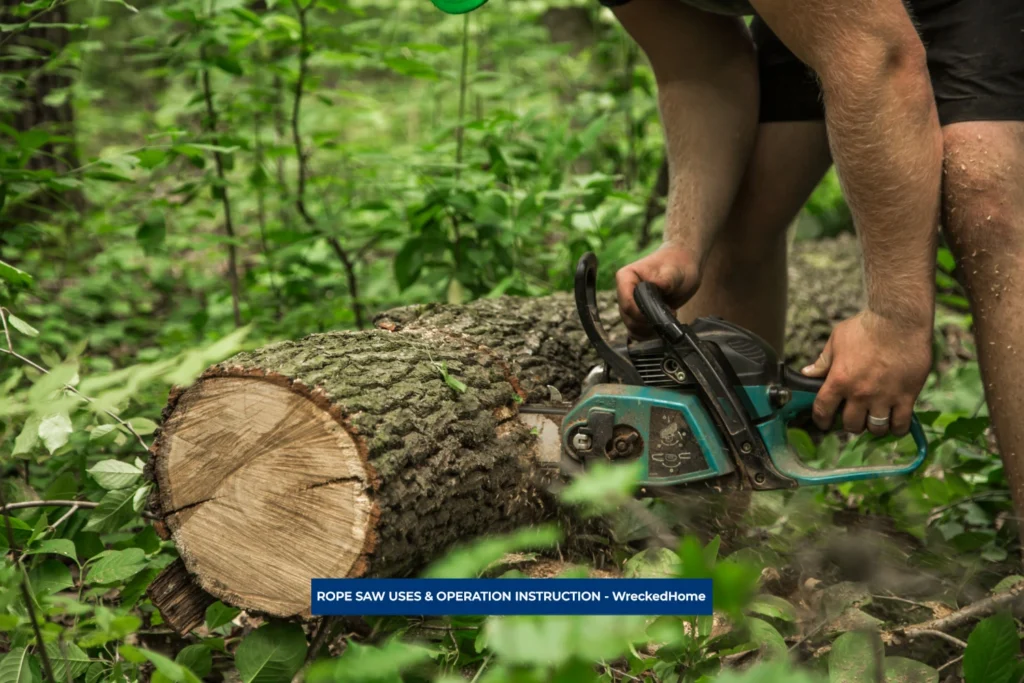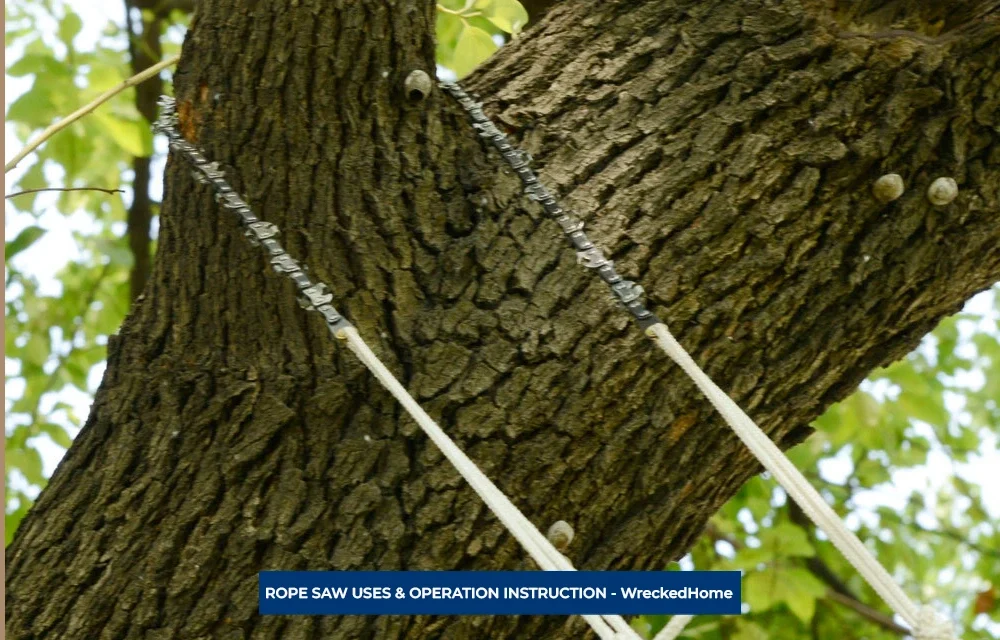Rope saws are tools that are versatile in nature and cover gaps between traditional and modern cutting implements. There are numerous indispensable uses of the rope saw in various applications. Offering a glimpse into their unique design, rope saws are durable to handle heavy duty tasks. This innovation allows for efficient cutting in tight or hard-to-reach spaces that is convenient and efficient in working.
The significance of comprehending the diverse applications and proper operation of rope saws is important when delicately pruning branches. For more effective results in cutting, users must grasp the intricacies of these tools to harness their full potential. The nuanced skill of handling a rope saw not only ensures optimal performance but also lowers the risk factors by deeply understanding the proper ways to use.
In this guide, we will be deciphering the uses and operational nuances of this tool, to ensure work efficacy with precision and confidence. So, let’s unravel the multifaceted world of rope saws, to get proper cutting results.
- Types Unveiled: Navigating the Diverse Realm of Rope Saws
- Common Uses of Rope Saws
- 1. Mastering the Art: Operation Instructions for Rope Saws
- 2. Safety First: Gear Up for Success
- 3. Choosing the Right Blade: Tailoring Precision to the Task
- 4. Securing the Rope: Foundation for Stability
- 5. Proper Cutting Angles: The Dance of Precision
- 6. Maintain Control and Stability: The Key to Mastery
- 8 Crucial Tips for Rope Saw Operation
- 1. Personal Protective Gear: Shielding the Warrior
- 2. Pre-Operation Inspection: Ensuring Equipment Integrity
- 3. Adequate Training: The Wisdom of Mastery
- 4. Clear Work Area: Creating a Safe Zone
- 5. Controlled Motion: The Rhythm of Safety
- 6. Proper Body Positioning: Aligning for Success
- 7. Mindful of Surroundings: Environmental Awareness
- 8. Emergency Preparedness: Ready for the Unexpected
- Conclusion
- FAQs
Types Unveiled: Navigating the Diverse Realm of Rope Saws

image by: fadfindings
Rope saws, often underestimated in their diversity, come in different types according to their respective functionality. Understanding the nuances of these types is paramount for users to choose according to their job. Some of the common types are
A. Traditional Hand-Operated Rope Saws: Embracing the Essence of Manual Mastery
In this digital world of technology, the charm of hand-operated rope saws endures. These tools, relying on the user’s physical prowess, offer hand on control and keep connection with craftsmanship from years. Its amazing design and traditional approach uncover the timeless utility of these manual marvels.
B. Motorized or Powered Rope Saws: Unleashing Cutting-edge Efficiency
Witness the mutual collaboration of technology and power with motorized rope saws. Propelled by engines or electric motors, these saws are efficient for short term task where you need precision and efficacy. This is a special gift for those who prefer a more modern approach.
C. Specialized Rope Saws for Different Purposes: Tailoring Tools to Tasks
Rope saws, adaptable by nature, can be fine-tuned according to applications and usage. Whether it’s for intricate pruning, emergency situations, or construction endeavors, there are specific features linked according to the situation. So, you can dive into the world of specialized rope saws, where precision meets purpose. For this you can order customize rope saws according to your work nature.
Common Uses of Rope Saws

Rope saws, with their nimble design and adaptable nature, are known as a good helper that requires a unique set of skills. On the basis of skill level you can endorse the precision of the rope saw. Let’s unravel the diverse tapestry of their common uses in the following way.
1. Mastering the Art: Operation Instructions for Rope Saws
Rope saws gracefully ascend to the treetops that leverage their flexibility to reach tight spots, ensuring the health and aesthetics of trees with surgical precision. Operating a rope saw requires finesse and understanding of usage. Here are key steps that are user oriented for a seamless and safe cutting experience.
2. Safety First: Gear Up for Success
Before embarking on any cutting task, you need to ensure you wear eye glasses, cap and gloves. These protective measures helpful in your safety also try to cove ear if applicable for hearing protection. Adequate protection not only safeguards you from potential injuries but also keeps your focus on your task.
3. Choosing the Right Blade: Tailoring Precision to the Task
Selecting the appropriate blade is important because the main task is based on the cutting nature of blades. Different blades excel in various scenarios, like from cutting branches, roots, and stems. Match the blade to the task at hand to get the precise result in less effort and time.
4. Securing the Rope: Foundation for Stability
A stable foundation is crucial for effective cutting and fostering a controlled environment that facilitates precise and accurate cuts. Before commencing, ensure the rope is securely anchored to provide stability for wielding the saw effectively, fostering a controlled environment that facilitates precise and accurate cuts. This foundational step establishes a controlled environment for a smoother and more controlled cutting experience, ultimately leading to the desired precision in each cut.
5. Proper Cutting Angles: The Dance of Precision
Mastering the art of the rope saw operation involves experimentation, exploring various angles to unearth the optimal approach tailored to your specific task. Whether you’re trimming branches or crafting wood, the key lies in comprehending and applying the right angles. You can experiment with different angles to find the optimal approach tailored to your specific tasks.
6. Maintain Control and Stability: The Key to Mastery
Throughout the operation, hinges are the unwavering commitment to prioritize control and stability. A controlled, steady motion guarantees the precision of your cuts but also provides protection against potential accidents. Maintain a firm grip on the handles, distribute your weight evenly, and move with purpose to enhance not just the quality of your work but also the security of the entire operation.
Visit our store for 10% off our Tools here.
8 Crucial Tips for Rope Saw Operation
Using a rope saw demands a mindful approach to safety that one can attain by care full planning. Here are eight essential safety tips that ensure safety and user friendly experience.
1. Personal Protective Gear: Shielding the Warrior
Prioritize your safety by wearing safety gears like glasses, gloves and cap. Equip yourself with useful shields to avoid against debris, and, when necessary, hearing protection. Creating a shield between you and the potential hazards lays you can focus on cutting without any fear of damage. It can also save the lives of user by providing protection.
2. Pre-Operation Inspection: Ensuring Equipment Integrity
Before igniting the saw’s blades, conduct a thorough inspection to see the rope saw condition and blades sharpness. Confirm that safety features, such as blade guards, are functional that can lower the require time and effort. The timely upkeep and check to reduce the risk of unexpected malfunctions during operation.
3. Adequate Training: The Wisdom of Mastery
Before wielding a rope saw, you need to spend time in training. With proper training you will learn proper usage, techniques, and safety precautions. In this way, familiarity with the tool give you confidence and boot competence, reducing the likelihood of accidents due to lack of expertise.
4. Clear Work Area: Creating a Safe Zone
Establish a clutter-free workspace where you can perform cutting task without any attention diversion. Remove potential tripping hazards, secure loose items, and make an environment that boosts your efficacy. It is necessary because a tidy work area not only enhances your maneuverability but also lower the risk to get harm.
5. Controlled Motion: The Rhythm of Safety
Operate the rope saw with purpose and control that ensures safety of the user. Avoid hurried or erratic movements that can result in loss of control on tool. Maintaining a steady and deliberate motion not only ensures precise cuts but also avoid from any mishap like slipping or wrong movement.
6. Proper Body Positioning: Aligning for Success
Do you known that the use of body posture also matters in crafting? Position your body strategically during operation that minimize the risk factors and induce more work forces. Distribute your weight evenly, maintaining a stable stance for more alignment in direction of motion to enhance control.
7. Mindful of Surroundings: Environmental Awareness
Stay vigilant to your surroundings to attain stable performance and remove distraction. Be aware of potential hazards such as unstable branches, to reduces the risk of accidents and promotes a safe cutting environment.
8. Emergency Preparedness: Ready for the Unexpected
If you face any trouble then you must know how to control it. Familiarize yourself with emergency shutdown procedures that ensure your safety and keep your hard work safe. Preparedness is the key to swiftly and effectively handling the working situations.
By following these tips you can get an effortless cutting experience. It is also a source of safety to guard with these safety measures.
Conclusion
In the intricate dance between man and tool, the rope saw emerges as important. The mastery of its art requires a harmonious blend of knowledge, skill, and safety consciousness.
From the nostalgic simplicity of hand-operated ones to the cutting-edge efficiency uses of rope saws span from the heights of tree pruning to the depths of emergency survival.
It is a tool that becomes part of our lives. Therefore by understanding the anatomy of the rope saw, how blades, handles, and safety features harmonize to create a tool that balances precision with power. The operation instructions provided a road map for wielding and ensure the safety and precision.
Personal protective gear, pre-operation inspections, and in the hands of the adept, become a conduit for artistic craftsmanship.
For any repairs, installations, builds, or questions; We recommend you to hire a professional. Find A Pro Near You Here!
FAQs
What is a rope saw?
The Tree Help Rope Saw (Professional) is a cutting tool that consists of the 48-inch Bimatic carbon steel chain blade, two 25-foot lengths of rope, and a throwing weight. It offers an ease in cutting the wood and any other material.
What can a pole saw cut?
A pole saw is a standard saw affixed to a long handle that is mainly use to cut tree branches. This tool proves invaluable for maintaining landscaping efficiently, and allows work without any requirements of ladder.
How long is a pole saw?
In the realm of pole saws, bar lengths vary that on average lie in between of 8 to 12 inches. On the other hand, manual pole saws tend to have longer bar lengths that can be in range of 12 to 16 inches. The bar length is a critical factor that impacts efficacy and cutting capacity.
Thumbnail by: countryhomeproducts





































